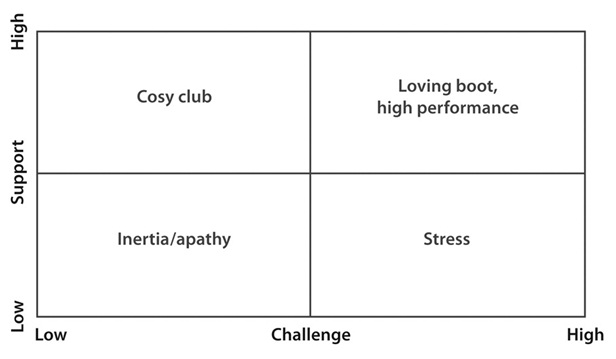Ian Day and John Blakey continue their series on challenging leadership. This time round, it's about negotiation.
Our latest example of applying the high support / high challenge ‘loving boot’ approach to leadership focusses upon client negotiation – a crucial and unavoidable business process which can make or break the success of a business. There are customer service mantras which say “the customer is King” and “the customer is always right”, but more recently these have been questioned. The customer is not always right; the very nature of the interaction makes the supplier the expert. The customer may not know what he/she needs or wants and what the customer wants may not always make good business for a supplier. Every customer would want the highest quality at the lowest price, but from a supplier’s perspective there is no economic margin in a transaction based on providing a Rolls Royce for the price of a Nissan Micra.

In the context of the above diagram, in a high challenge / high support approach client negotiation is about building a contract which is honoured through speaking your truth, providing feedback, being comfortable with tension and being prepared to enter the zone of uncomfortable debate (ZOUD). In contrast, in a low challenge / high support approach a supplier says ‘yes’ to everything a customer wants and there is a risk that a contract is built which cannot be honoured. Consider the following dialogue:-
Leader: We are 12 months into this five-year contact and this is a good time to review and take stock. I would welcome your feedback.
Customer: Well, after an initial honeymoon period we had a few problems which you are aware of, however that has settled down now and we are pleased with the service over the last four months.
Leader: What has particularly pleased you?
Customer: Your account management team are now very fast at responding to our requests for information. Previously it would take them up to a week to respond; now it is a matter of hours.
Leader: I’m glad you mentioned the requests for additional information as this is something I want to talk about. The requests for additional information have increased over time, initially from one a month in the first two months, to 10 a month in the last four months. Unfortunately with these requests for additional information the scope of the contract has expanded. What is your take on this?
Customer: Yes, this additional information is useful and gives us valuable real-time data and we would like this to continue.
Leader: I’m pleased we are able to add value. You will remember that the contract mentioned that work out of scope is chargeable, and given the level of work I want to discuss the charges with you.
Customer: This was not what I was expecting, and I don't have funds available for extra fees.
Leader: I understand this is a surprise but this is an important area to talk through face-to-face. I have calculated that the additional work is taking up half a day a week above the normal contacted work, which is clearly significant.
Customer: Like I said, I do not have additional funds.
Leader: I hear what you say, but we entered into this relationship with a clearly defined contract. You and I spent weeks getting the contract right, now it is time to put all that effort to good use.
Customer: I remember the effort to get the contract right, but I expect you to do the extra work as a gesture of goodwill given the size and duration of this deal.
Leader: That is what we have been doing for the last four months, it is time to either stop this additional work or if the information is adding value to your business we will charge for it as agreed in the contract.
Customer: I can see this is an important issue to you and you are not going to back down. This partnership has worked well up to now, and yes the additional work has been valuable. Ok – I'll pay from 1 April onwards. However, I want a detailed breakdown of the additional work, with time spent and you and I will sit down to review this every six months.
Leader: Thank you. We can do that and I look forward to keeping up the standards of service on the work.
By being in the high support / high challenge quadrant the leader avoids the risks of the ‘cosy club’ where excessive support and little challenge risks creating a customer relationship where the customer routinely exploits the situation in order to squeeze more and more out of the supplier. Equally, by avoiding the high challenge / low support stress zone, the leader ensures that the customer does not feel exploited themselves, risking a breakdown in the relationship and escalation to more serious contractual disputes.
As with earlier examples in our series on challenging leadership, the ‘loving boot’ represents an adult-adult conversation where the leader’s prime responsibility is to create an environment where all can speak their truth openly. In this situation high challenge and high support represents a win / win for both customer and supplier. Both the leader and the customer can leave the conversation with clear expectations and mutual commitments. The customer is not always right and is not always King but they always deserve our honesty and our respect.
Ian and John's book 'Challenging Coaching– Going beyond traditional coaching to face the FACTS' published by Nicholas Brealey Publishing is available on Amazon. More resources, including a free chapter download can be accessed via www.challengingcoaching.co.uk. This is an ongoing monthly column in Training Zone to explore the detail of challenging leadership.
Ian Day and John Blakey continue their series on challenging leadership. This time round, it's about negotiation.
Our latest example of applying the high support / high challenge ‘loving boot’ approach to leadership focusses upon client negotiation - a crucial and unavoidable business process which can make or break the success of a business. There are customer service mantras which say “the customer is King” and “the customer is always right”, but more recently these have been questioned. The customer is not always right; the very nature of the interaction makes the supplier the expert. The customer may not know what he/she needs or wants and what the customer wants may not always make good business for a supplier. Every customer would want the highest quality at the lowest price, but from a supplier’s perspective there is no economic margin in a transaction based on providing a Rolls Royce for the price of a Nissan Micra.

In the context of the above diagram, in a high challenge / high support approach client negotiation is about building a contract which is honoured through speaking your truth, providing feedback, being comfortable with tension and being prepared to enter the zone of uncomfortable debate (ZOUD). In contrast, in a low challenge / high support approach a supplier says ‘yes’ to everything a customer wants and there is a risk that a contract is built which cannot be honoured. Consider the following dialogue:-
Leader: We are 12 months into this five-year contact and this is a good time to review and take stock. I would welcome your feedback.
Customer: Well, after an initial honeymoon period we had a few problems which you are aware of, however that has settled down now and we are pleased with the service over the last four months.
Leader: What has particularly pleased you?
Customer: Your account management team are now very fast at responding to our requests for information. Previously it would take them up to a week to respond; now it is a matter of hours.
Leader: I’m glad you mentioned the requests for additional information as this is something I want to talk about. The requests for additional information have increased over time, initially from one a month in the first two months, to 10 a month in the last four months. Unfortunately with these requests for additional information the scope of the contract has expanded. What is your take on this?
Customer: Yes, this additional information is useful and gives us valuable real-time data and we would like this to continue.
Leader: I’m pleased we are able to add value. You will remember that the contract mentioned that work out of scope is chargeable, and given the level of work I want to discuss the charges with you.
Customer: This was not what I was expecting, and I don't have funds available for extra fees.
Leader: I understand this is a surprise but this is an important area to talk through face-to-face. I have calculated that the additional work is taking up half a day a week above the normal contacted work, which is clearly significant.
Customer: Like I said, I do not have additional funds.
Leader: I hear what you say, but we entered into this relationship with a clearly defined contract. You and I spent weeks getting the contract right, now it is time to put all that effort to good use.
Customer: I remember the effort to get the contract right, but I expect you to do the extra work as a gesture of goodwill given the size and duration of this deal.
Leader: That is what we have been doing for the last four months, it is time to either stop this additional work or if the information is adding value to your business we will charge for it as agreed in the contract.
Customer: I can see this is an important issue to you and you are not going to back down. This partnership has worked well up to now, and yes the additional work has been valuable. Ok - I'll pay from 1 April onwards. However, I want a detailed breakdown of the additional work, with time spent and you and I will sit down to review this every six months.
Leader: Thank you. We can do that and I look forward to keeping up the standards of service on the work.
By being in the high support / high challenge quadrant the leader avoids the risks of the ‘cosy club’ where excessive support and little challenge risks creating a customer relationship where the customer routinely exploits the situation in order to squeeze more and more out of the supplier. Equally, by avoiding the high challenge / low support stress zone, the leader ensures that the customer does not feel exploited themselves, risking a breakdown in the relationship and escalation to more serious contractual disputes.
As with earlier examples in our series on challenging leadership, the ‘loving boot’ represents an adult-adult conversation where the leader’s prime responsibility is to create an environment where all can speak their truth openly. In this situation high challenge and high support represents a win / win for both customer and supplier. Both the leader and the customer can leave the conversation with clear expectations and mutual commitments. The customer is not always right and is not always King but they always deserve our honesty and our respect.
Ian and John's book 'Challenging Coaching– Going beyond traditional coaching to face the FACTS' published by Nicholas Brealey Publishing is available on Amazon. More resources, including a free chapter download can be accessed via www.challengingcoaching.co.uk. This is an ongoing monthly column in Training Zone to explore the detail of challenging leadership.




